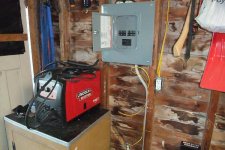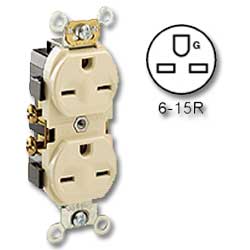Doctorbass
100 GW
I am tired of waiting the charger to end the charge process at 1700W max power.. I WANT MORE !!! 
The poor thing is that my actual garage is equiped of only ONE 15A breaker on 120V.. !yes... just one!! It supply all the fluo, computer adn other devices i teh garage so to charge my ebike i must shutdown everything else !!!
I have 5 Kilowatts total of industrial Meanwell power supply so.. i must make a move!!
I plan on adding an auxiliary electrical box in the garage so all the garage outlet will be supplyed thru it only.
I plan on adding one two poles 30A 220V breakerbreaker on the actual home electrical box ( one on each phase availlable) and than to start from them a 4 wire cable 6AWG to the garage electrical box.
I'll have:
-one single phase breaker of 120V 15A for the actual circuit,
-one more single phase breaker for the actual circuit for added 120V outlet close to the work bench,
-one single phase 220V 15A outlet for the charger
- and than one 220V 4 lead 2 phase standard plug
I know the total max power above is exceeding the 30A 220V breaker i'll install in the actual home electrical box but i will vener use all that power at the same time i the garage.
I have a good idea on "how to... and how it work" but my only experience is that i installed switch and outlets and few breakers.. but never a second electrical box..
Should i go with what it's called a sub panel ?
Any recommandations , or expertise from electrician ?
Thanks in advance
Doc
The poor thing is that my actual garage is equiped of only ONE 15A breaker on 120V.. !yes... just one!! It supply all the fluo, computer adn other devices i teh garage so to charge my ebike i must shutdown everything else !!!
I have 5 Kilowatts total of industrial Meanwell power supply so.. i must make a move!!
I plan on adding an auxiliary electrical box in the garage so all the garage outlet will be supplyed thru it only.
I plan on adding one two poles 30A 220V breakerbreaker on the actual home electrical box ( one on each phase availlable) and than to start from them a 4 wire cable 6AWG to the garage electrical box.
I'll have:
-one single phase breaker of 120V 15A for the actual circuit,
-one more single phase breaker for the actual circuit for added 120V outlet close to the work bench,
-one single phase 220V 15A outlet for the charger
- and than one 220V 4 lead 2 phase standard plug
I know the total max power above is exceeding the 30A 220V breaker i'll install in the actual home electrical box but i will vener use all that power at the same time i the garage.
I have a good idea on "how to... and how it work" but my only experience is that i installed switch and outlets and few breakers.. but never a second electrical box..
Should i go with what it's called a sub panel ?
Any recommandations , or expertise from electrician ?
Thanks in advance
Doc



